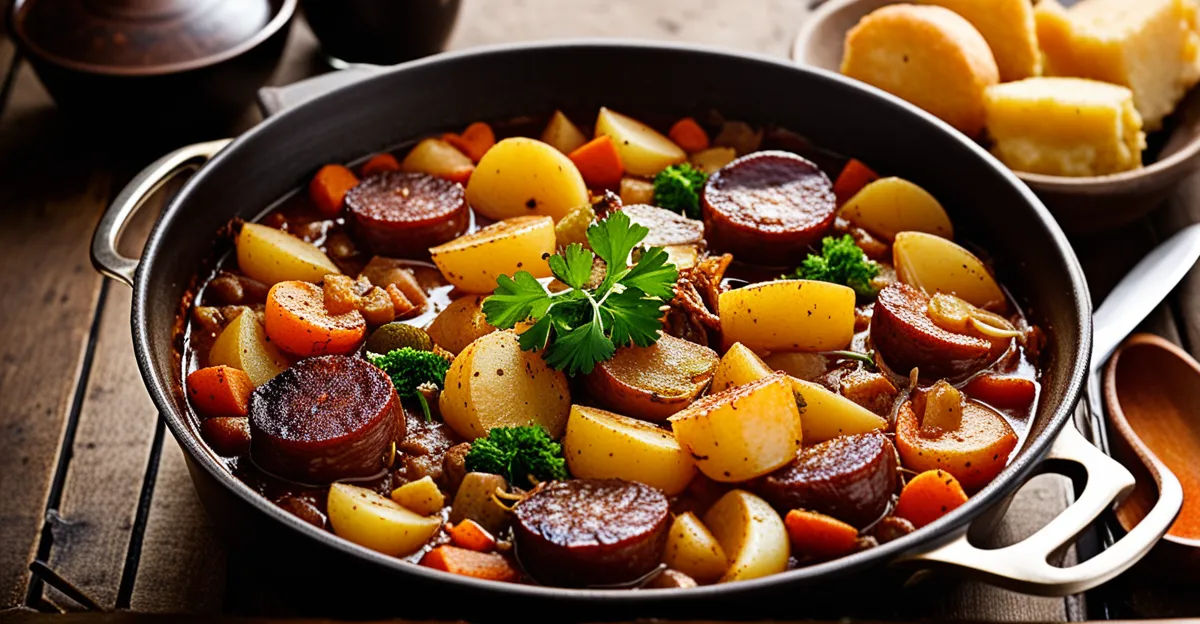How can you recreate a traditional Lancashire hotpot at home?

Essential Ingredients for an Authentic Lancashire Hotpot
To craft a genuinely traditional Lancashire hotpot, focus on a few core ingredients that define this classic British dish. The foundational elements are tender lamb, thinly sliced potatoes, and sweet onions. Lamb brings rich, hearty flavors, while the potatoes form a golden crust, and onions add subtle sweetness, balancing the dish.
Selecting quality ingredients is crucial. Opt for well-sourced cuts of lamb, preferably shoulder or neck, known for their tenderness and flavour when slow-cooked. Fresh, waxy potatoes work best as they hold their shape during baking. Onions should be firm and fresh to enhance the dish’s aromatic profile.
Topic to read : Analyzing the Rich History of British Cuisine: How Did Traditional Dishes Evolve Over Time?
While the traditional hotpot recipe is simple, optional additions can deepen flavor or suit personal tastes. Some cooks add a splash of broth or a hint of thyme for complexity. Common substitutes may include beef or mutton instead of lamb, but purists argue this alters the authentic taste.
Understanding the importance of these Lancashire hotpot ingredients lays the groundwork for making an unmistakable classic British dish that honors Lancashire’s culinary heritage.
Also read : How can you create a perfect fish and chips experience at home?
Step-by-Step Preparation and Cooking Instructions
Mastering the art of a classic Lancashire hotpot
Understanding how to make Lancashire hotpot involves precise layering and slow cooking to meld flavors. Begin by gently browning the lamb to enhance taste and seal in juices. This step elevates the dish beyond a simple stew, maximizing its rich essence.
Next, carefully layer the ingredients. Place the tender lamb at the base of a heavy casserole dish, then cover it with a thick bed of sliced onions. Finally, arrange thinly sliced, waxy potatoes on top, overlapping slightly to create a crust that crisps beautifully during cooking.
Cover the dish tightly with a lid or foil to trap moisture and slowly cook at a low temperature—around 160°C (320°F)—for approximately two to three hours. This slow cooking allows the lamb to become tender while the potatoes develop a golden, rustic finish.
Following these cooking instructions ensures the hotpot maintains its traditional British cooking techniques. Attention to layering and temperature is key to achieving that authentic texture and flavor that defines the classic Lancashire hotpot.
Achieving Authentic Flavor and Traditional Presentation
To capture the authentic Lancashire hotpot flavor, seasoning plays a pivotal role. Salt and pepper are essential, but adding fresh or dried thyme enhances the classic hotpot flavor profile without overpowering the dish. Some cooks use a splash of good-quality lamb stock or broth during layering to deepen the richness. The slow cooking naturally develops a complex taste, so avoid excessive seasoning early on to maintain balance.
Texture is another hallmark of traditional British comfort food like this hotpot. The potatoes must form a crisp, golden crust contrasting with the tender lamb beneath. A well-layered hotpot should show evenly cooked vegetables with the lamb soft enough to fall apart easily, inviting the comforting experience expected of this classic.
When serving, patience is key—letting the hotpot rest briefly after cooking helps the juices redistribute, enhancing flavor and presentation. Traditionally, it’s served straight from the casserole dish, allowing diners to enjoy the rustic feel of this British classic. Minimal garnishing, perhaps with a sprinkle of fresh parsley, respects its simple heritage while adding a visual touch.
Mastering these nuances ensures your authentic Lancashire hotpot delivers both classic hotpot flavor and the comforting essence of British culinary tradition.
Serving Suggestions and Enjoying Your Lancashire Hotpot
When considering Lancashire hotpot serving suggestions, traditional British meal ideas often include simple, rustic accompaniments that complement the rich flavors. Classic sides such as steamed cabbage, carrots, or mushy peas offer freshness without competing against the hearty hotpot.
Pairing the hotpot with a robust, earthy ale or mild beer works well, balancing the meaty richness and highlighting the traditional British food heritage. For non-alcoholic options, a sharp apple cider or sparkling water with lemon can brighten the palate.
Leftovers keep well and often benefit from gentle reheating to preserve the texture of the potatoes and tenderness of the lamb. Reheating in a moderate oven, around 150°C (300°F), under foil prevents drying. Avoid microwaving, as this can break down the texture and diminish the classic hotpot flavor.
Incorporating these Lancashire hotpot serving suggestions not only honors the dish’s humble origins but also elevates the overall dining experience, making the meal both satisfying and authentically British. With thoughtful side dishes and mindful reheating, you can enjoy this cherished classic again and again.
Traditional Origins and Regional Variations
The Lancashire hotpot’s history traces back to the industrial north of England, where it served as a nourishing, affordable meal for workers. Rooted in Lancashire’s rich British food heritage, it reflects the region’s reliance on local lamb and seasonal vegetables, showcasing the practicality of using simple, hearty ingredients.
Regional variations highlight the dish’s adaptability within British cuisine. For instance, some areas substitute mutton or beef when lamb is scarce, though this shifts the hotpot’s traditional flavor. Others may incorporate root vegetables like turnips or carrots alongside onions, adjusting the recipe while keeping the comforting essence intact.
Modern adaptations still honor the classic method but often experiment with herbs and broths for additional layers of flavor. Despite these changes, the slow-cooked layering and golden potato topping remain constant hallmarks, preserving the character of this beloved traditional hotpot recipe.
Understanding these hotpot variations deepens appreciation for its place in British culinary history, showing how this simple stew has evolved yet stayed true to its Lancashire origins and continued popularity in classic British dishes.
